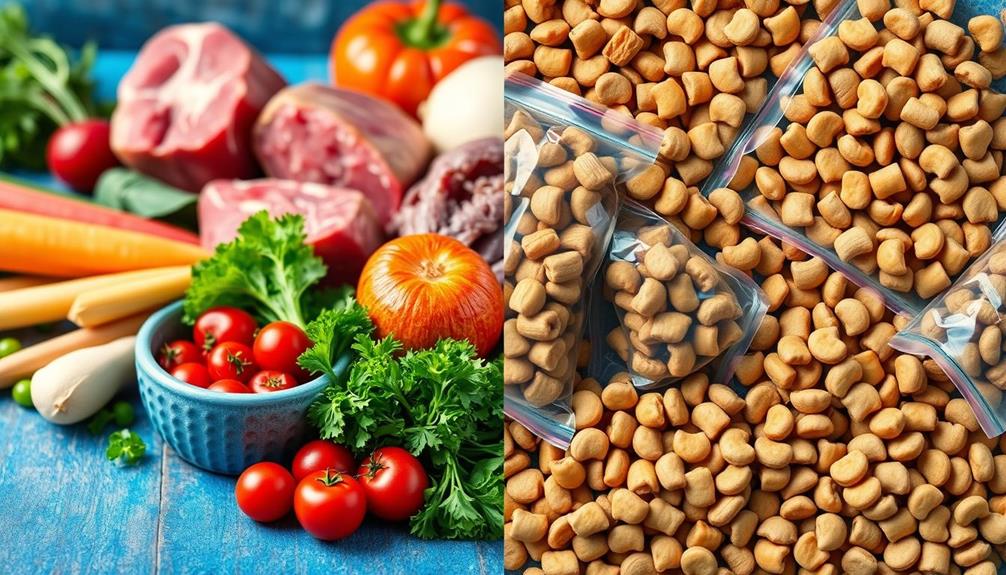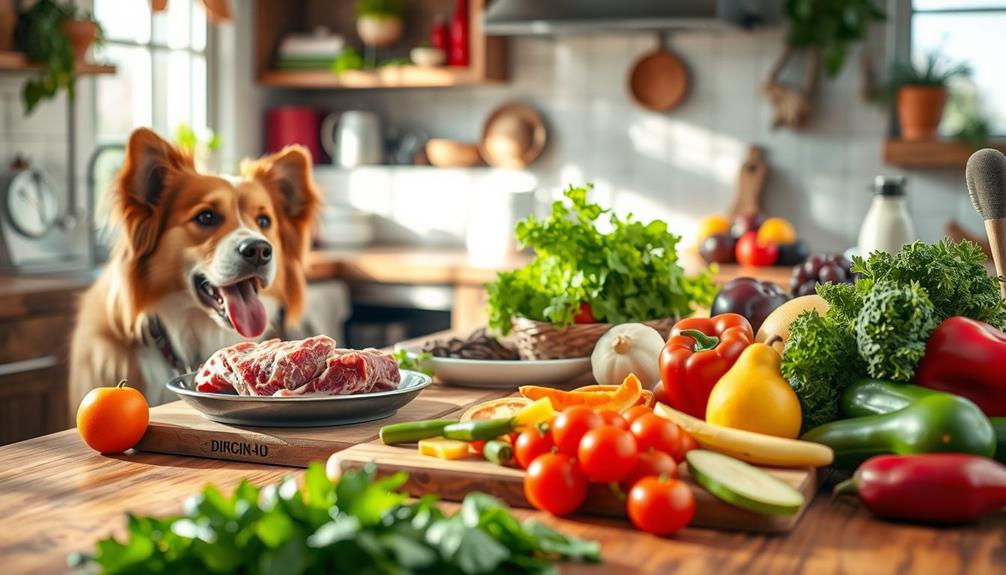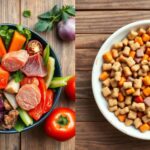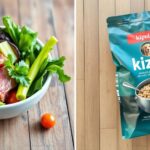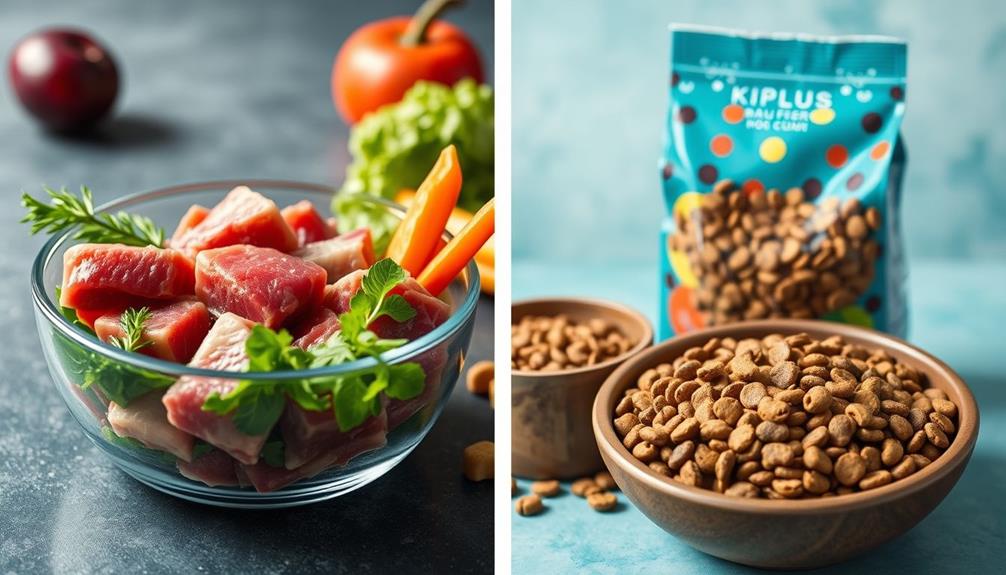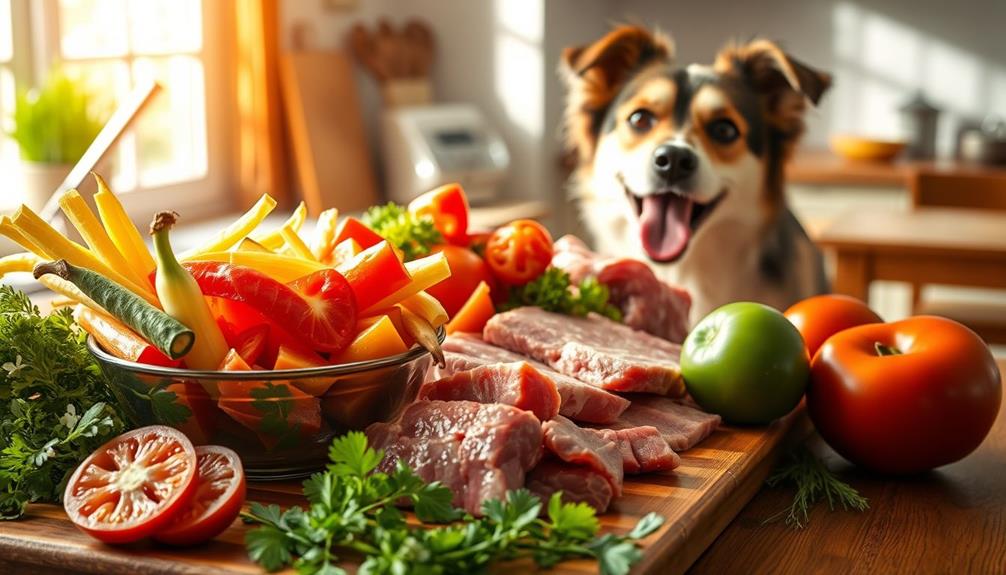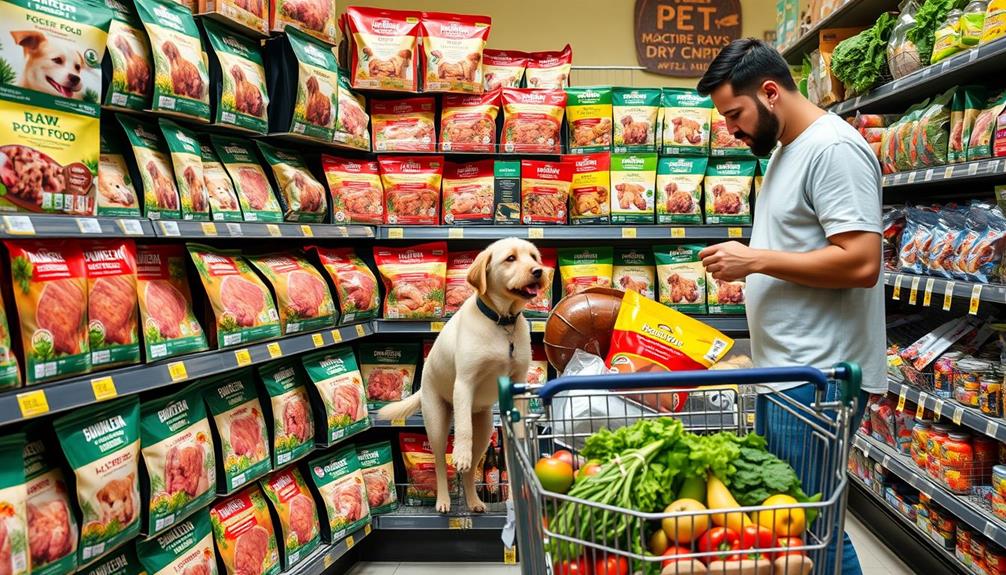Choosing between raw food and dry food for your dog can greatly impact their health. Raw diets provide higher protein and fat levels, aligning with your dog's natural needs, while also promoting better hydration and digestion. On the other hand, dry food is convenient, cost-effective, and can support dental health. However, it often contains more carbohydrates and fewer beneficial nutrients. Both options come with their pros and cons, so it's essential to weigh these factors carefully. If you're curious about how to make the best choice for your furry friend, there's more insight waiting for you.
Key Takeaways
- Raw food diets are higher in protein and moisture, aligning more closely with a dog's natural dietary needs compared to kibble.
- Kibble is cost-effective and convenient, but it often contains harmful fillers and low moisture content, which may impact hydration.
- Raw diets may enhance digestion and overall health, while kibble can contain inflammatory compounds that affect well-being.
- Proper handling and veterinary guidance are critical for safely implementing a raw food diet to minimize health risks.
- Owner experiences often highlight improved energy and coat health with raw diets, though challenges in preparation and nutritional balance exist.
Overview of Dog Diets
When it comes to dog diets, there are three main categories you should consider: raw diets, kibble (dry food), and fresh food. Each type has distinct nutritional profiles that can affect your dog's health.
Raw diets typically consist of uncooked meats, bones, and organs, emphasizing high protein and low carbohydrates. This approach aims to meet your dog's nutritional needs naturally, although it requires careful handling to mitigate risks from pathogens like Salmonella and E.coli.
On the other hand, kibble is often high in processed carbohydrates, making up about 30%-40% of its content. While kibble must meet USDA regulations for safety and nutritional balance, it's essential to recognize that some studies suggest the inflammatory effects of advanced glycation end products (AGEs) found in processed foods may impact your dog's health negatively.
Fresh food diets include natural ingredients like beef, chicken, and vegetables. When formulated by veterinary nutritionists, these diets can enhance heart health and energy levels, ensuring your dog receives balanced nutrition.
Ultimately, the choice between raw diets and kibble can greatly influence your dog's overall well-being, so consider your options carefully when feeding your dog.
Benefits of Raw Food

When you consider switching your dog to a raw food diet, you'll find that it offers significant nutritional benefits.
The higher protein and fat levels closely match your dog's natural dietary needs, which can lead to improved digestive health as well.
Additionally, incorporating natural ingredients in their diet, like high-quality protein sources, can enhance their energy levels and overall wellness.
Plus, the moisture content in raw food helps keep your pup hydrated, making it a wholesome choice overall.
Nutritional Benefits Overview
Raw dog food stands out as a nutritional powerhouse, delivering balanced, species-appropriate nutrition that aligns with your dog's ancestral eating habits.
One of the considerable nutritional benefits of raw food is its high moisture content, ranging from 70-75%. This promotes better hydration compared to kibble, which only contains about 5-10% moisture. Additionally, incorporating more natural ingredients can enhance your dog's overall well-being, as cold medications overview can provide insight into the benefits of avoiding artificial additives.
Moreover, raw diets are typically lower in carbohydrates, often under 10%, reducing the risk of obesity and related health issues since dogs don't have a biological need for carbs. This low-carb approach can considerably enhance your dog's overall health.
You'll also notice improved skin and coat health when you switch to raw food. The natural nutrients in raw diets promote a shinier coat and healthier skin.
Plus, by eliminating fillers and artificial preservatives found in processed kibble, you can expect increased energy levels in your dog, allowing them to be more active and playful.
Improved Digestive Health
Switching to a raw food diet can substantially boost your dog's digestive health. Raw diets typically contain 70-75% moisture content, compared to just 5-10% in kibble. This higher moisture content promotes better hydration, essential for ideal digestion.
Additionally, the natural enzymes found in raw food aid digestion and enhance nutrient absorption, which are often lost during kibble processing. Incorporating gentle stretching into your dog's routine can further support their digestive system by promoting relaxation and reducing stress.
A raw diet usually features a lower carbohydrate content, generally under 10%. This aligns more closely with your dog's natural dietary needs, helping to prevent obesity and other digestive issues linked to excessive carbs. Many dog owners notice firmer fecal consistency when their pets are on a raw diet, indicating improved digestion and nutrient utilization.
Furthermore, raw food is free from fillers, gluten, and artificial preservatives, contributing to better overall digestive health. By eliminating these potential irritants, you're reducing the risk of gastrointestinal problems, making your dog's digestive system more efficient.
Benefits of Dry Food

Choosing dry food for your dog offers several compelling benefits that cater to both your pet's health and your budget. Dry food, or kibble, is a cost-effective choice, with daily expenses typically ranging from $1 to $13. This accessibility makes it easier for you to provide your dog with a reliable diet.
Additionally, ensuring your dog's overall health includes considerations for financial planning for care and nutrition, making dry food an appealing option.
One major advantage of kibble is its use of preservatives, which help prevent rancidity and extend shelf life. This means you can store it without worrying about spoilage, making it a convenient option for busy pet owners.
Additionally, high-quality kibble adheres to USDA regulations for nutritional balance and safety, ensuring your dog receives the necessary nutrients.
Another benefit of dry food is its positive impact on dental health. The crunchy texture of kibble encourages chewing, which can help reduce plaque buildup, promoting healthier teeth and gums.
Nutritional Comparison

When comparing the nutritional profiles of raw and dry dog food, it's clear that each option has distinct advantages. Raw food typically offers higher protein and fat levels, which are more easily digestible than the 30%-40% carbohydrates found in kibble. The moisture content in raw diets—about 70-75%—promotes better hydration and aids digestion, while kibble contains only 5-10% moisture.
Moreover, a focus on high-quality ingredients in raw diets can help avoid potential gastrointestinal issues associated with certain fillers in kibble, like those found in processed foods. Nutritional benefits of raw food emphasize its appeal for ideal canine health.
Kibble often includes non-beneficial fillers and artificial preservatives that dilute its nutritional value. In contrast, raw food emphasizes high-quality ingredients and species-appropriate nutrition without unnecessary carbohydrates. This focus on natural ingredients helps minimize nutritional deficiencies in your dog's diet.
Additionally, raw diets may reduce inflammation by avoiding advanced glycation end products (AGEs) produced during the kibble processing. Dogs on raw diets often show improved skin and coat conditions, firmer fecal consistency, and better overall health markers.
Health Implications
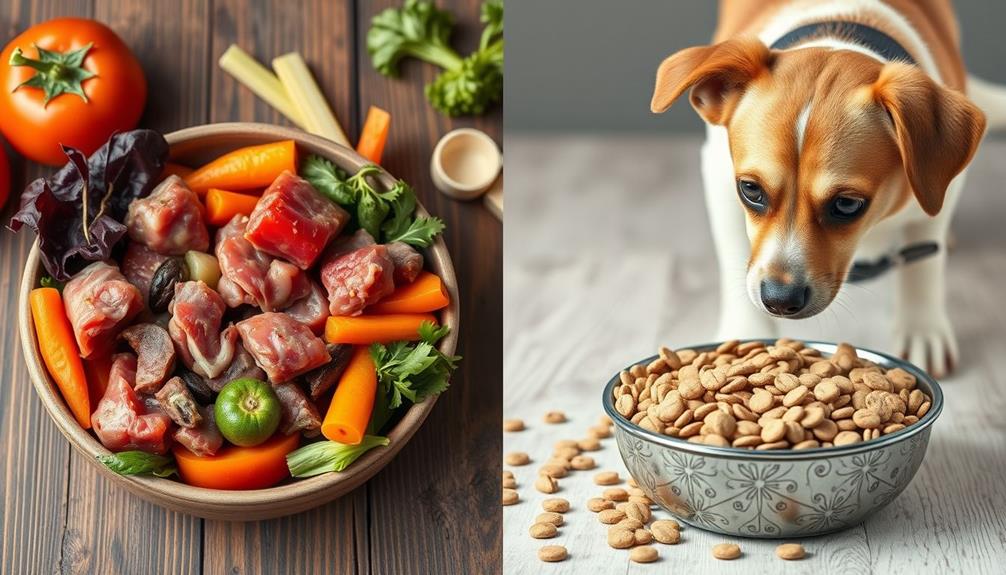
When considering the health implications of your dog's diet, it's essential to compare the nutritional benefits of raw versus kibble.
Raw diets may enhance digestive health and lower the risk of chronic diseases due to their natural composition and lower inflammatory potential.
Additionally, incorporating a holistic approach to your dog's wellness can include alternative therapies such as essential oils for skin conditions.
Understanding these differences can help you make informed choices for your dog's overall well-being.
Nutritional Benefits Comparison
How do raw food and dry food differ in their nutritional benefits for your dog? The nutritional profile of raw food and kibble varies greatly, impacting your dog's overall health. When comparing the two, consider these key points:
1. Protein and Fat: Raw food usually has higher protein and fat levels, aligning closely with a dog's natural dietary needs, while kibble can contain 30%-40% carbohydrates, which may not be beneficial.
Additionally, effective strategies for weight loss can be applied to managing your dog's weight through appropriate food choices.
2. Inflammation and Digestibility: Kibble can produce advanced glycation end products (AGEs), potentially leading to inflammation and chronic diseases.
In contrast, raw diets are generally more digestible due to their higher moisture content (70-75%) and natural enzymes, promoting better health.
3. Quality of Ingredients: Kibble often includes fillers and artificial preservatives that dilute its nutritional value.
Raw food emphasizes high-quality, bioavailable ingredients, which are more beneficial for your dog.
Digestive Health Impact
The digestive health impact of a dog's diet plays a crucial role in their overall well-being. When you consider a raw diet, you'll notice it typically contains 70-75% moisture content, which promotes better hydration and aids digestion. In contrast, kibble only has 5-10% moisture, making it less effective for hydration.
Additionally, the high carbohydrate levels in kibble, ranging from 30%-40%, can lead to digestive issues and obesity, whereas raw diets keep carbohydrates under 10%, aligning more closely with your dog's natural dietary needs.
Individuals with Borderline Personality Disorder (BPD) may struggle with emotional dysregulation, which can parallel how dogs react to dietary changes and their overall health. Raw dog food is often easier to digest due to the presence of natural enzymes, while kibble processing destroys crucial nutrients, reducing their bioavailability.
Dogs on a raw diet generally show firmer fecal consistency and improved digestive health, with studies indicating significant improvements in fecal quality compared to kibble-fed dogs (P < 0.0001).
In addition, feeding practices differ dramatically; about 85% of Raw Meat-Based Diet (RMBD) dogs receive dietary supplements, enhancing nutrient intake, while only 24% of kibble dogs do.
Choosing the right diet can profoundly affect your dog's digestive health.
Disease Risk Assessment
Choosing between raw and dry food for your dog involves considering various health implications, particularly regarding disease risk. Both raw food and kibble have their advantages and risks, so it's crucial to evaluate these factors carefully.
For instance, mammography aims to detect potential health issues early, much like how monitoring your dog's diet can help identify and prevent health problems before they escalate.
- Bacterial Contamination: Raw diets can expose your dog to harmful bacteria like E. coli and Salmonella, which can lead to serious illnesses in both dogs and humans, especially in households with vulnerable individuals.
- Chronic Disease Links: Kibble, though convenient, may contain advanced glycation end products (AGEs) due to high-temperature processing. These can promote inflammation, potentially increasing the risk of chronic diseases.
- Immune Response: Studies indicate that dogs on raw meat-based diets (RMBD) show a higher lymphocyte count, suggesting a stronger immune response. This could offer protective benefits, particularly against certain liver-related issues compared to kibble-fed dogs.
While raw food can improve coat and skin health, you must manage nutritional balance carefully to avoid deficiencies and associated health risks.
Ultimately, evaluating the disease risk of each option will help you make an informed decision for your furry friend.
Choosing the Right Option
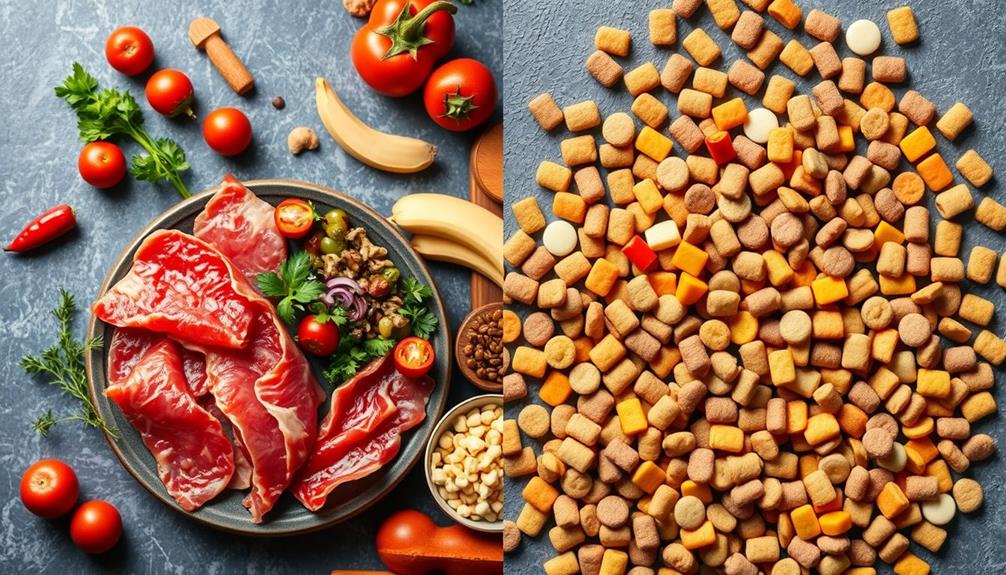
Deciding between raw food and dry food for your dog can feel overwhelming, but understanding a few key factors can simplify the process.
First, consider your dog's nutritional needs. Raw food typically boasts higher protein and fat levels, which can be beneficial, especially for active dogs. In contrast, dry food often contains 30%-40% carbohydrates, potentially leading to obesity if not managed properly.
It's also important to guarantee that any diet you choose includes safe snacks, similar to how safe snacks for hamsters can provide additional nutritional benefits in their diet.
Consulting with a veterinarian is vital, especially if your dog has existing health issues or digestive sensitivities. They can help determine which diet aligns best with your dog's unique needs.
If you decide to shift to raw food, do it gradually to avoid gastrointestinal upset. Mixing raw food with kibble can also enhance nutrition without a sudden change.
Pay close attention to ingredient quality. High-quality raw diets feature fresh, bioavailable ingredients, while some kibble brands may include fillers and artificial preservatives.
Regularly monitor your dog's health markers—like weight, energy levels, and coat condition—to guarantee the chosen diet supports their overall wellbeing.
Safety Considerations

When considering your dog's diet, safety is a crucial factor that can't be overlooked. Both raw food and kibble have their pros and cons, but you need to be aware of the risks involved, especially with raw diets. They can pose a higher risk of bacterial contamination, like E. coli and Salmonella, which can affect both your dog and vulnerable individuals in your home.
On the other hand, kibble is generally safer due to high-temperature processing that kills harmful pathogens.
Here are three important safety considerations:
- Proper Storage: Keep raw food refrigerated at appropriate temperatures to minimize spoilage and prevent bacterial growth.
- Veterinarians' Guidance: Consult with veterinarians who are knowledgeable in raw feeding to guarantee your dog's diet is safe and nutritionally balanced, as improper preparation can lead to nutritional deficiencies.
- Health Monitoring: Regularly monitor your dog's health during diet changes to catch any adverse reactions early.
Expert Recommendations
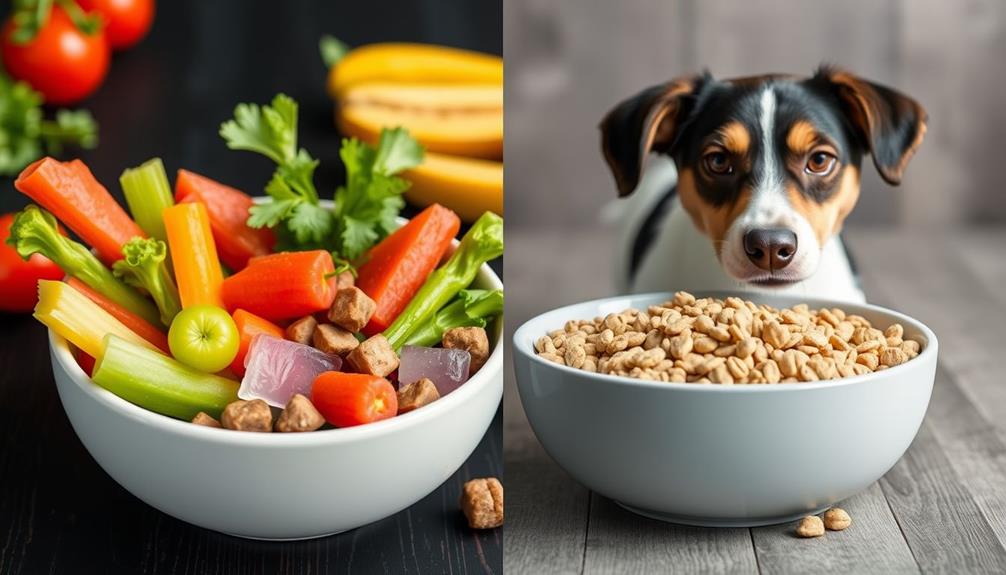
Veterinarians often emphasize the importance of consulting a professional before changing your dog to a raw food diet. A veterinary consultation is critical, as it guarantees the shift is tailored to your dog's specific needs and health status.
Raw food diets should be formulated with guidance from veterinary nutritionists to maintain nutritional balance and prevent deficiencies that could harm your pet.
When feeding raw, proper handling and sanitation practices are essential. This minimizes health risks associated with pathogens like Salmonella and E. coli, which can affect both pets and their owners.
Regular health monitoring is also recommended during this change. By observing any adverse reactions or improvements in health markers, you can make informed decisions about your dog's diet.
Educating yourself about ingredient sourcing is important, as it can lead to better choices for your pet. Understanding the benefits of fresh food and how to source it correctly can empower you as a pet owner.
Ultimately, the combination of professional advice, careful monitoring, and informed ingredient choices will help you navigate the complexities of feeding your dog a raw food diet safely and effectively.
Owner Experiences and Insights

As many dog owners immerse themselves in the world of raw feeding, they often find themselves sharing valuable insights and experiences that highlight the benefits and challenges of this dietary change.
You might hear about how shifting to raw diets has led to noticeable improvements in pet health. Here are some key takeaways from owner experiences:
- Improved Digestion: Many owners report their dogs have better digestion and firmer stools after changing, a significant change from kibble-fed diets.
- Enhanced Energy Levels: You'll find that dogs on raw diets often show increased energy and improved coat conditions, reinforcing the appeal of this feeding option.
- Food Preparation Challenges: While the benefits are clear, some owners express concerns about the time and effort needed for proper food preparation, including safe handling and sanitation.
Utilizing community resources like online forums and local co-ops can ease this shift, providing shared experiences and expert advice.
Consulting with veterinary nutritionists guarantees your dog receives balanced diets, making this journey rewarding for both you and your furry friend.
Frequently Asked Questions
Is Dry Food or Raw Food Better for Dogs?
When choosing dog food, consider your pet's needs. Dry food's convenience and cost-effectiveness are appealing, but raw diets may offer better nutrition and health benefits. Assess your lifestyle and your dog's health for the best choice.
What Is the Healthiest Food to Feed Your Dog?
When considering the healthiest food for your dog, focus on balanced nutrition that meets their specific needs. Always consult with your vet to guarantee you're providing the best possible diet tailored for your furry friend.
Do Vets Recommend a Raw Diet for Dogs?
About 70% of veterinarians support raw diets for healthy dogs, but they often caution against health risks. It's vital you consult a vet knowledgeable in raw diets to guarantee your dog's nutritional needs are met safely.
Is Fresh Food Really Better for Dogs Than Kibble?
When you consider fresh food for your dog, you'll find it often offers better nutrition, retaining essential enzymes. Just be sure to consult a vet for a balanced diet to avoid potential health risks.
Conclusion
In the end, the choice between raw and dry food depends on your dog's unique needs. Think of it like choosing between a gourmet meal and a convenient snack—both have their place. For instance, a friend of mine switched her dog to raw food and noticed a shiny coat and increased energy, like a flower blooming after the rain. Whichever path you choose, guarantee it's balanced and fits your pup's lifestyle to keep them happy and healthy. There are also benefits of dehydrated raw food for dogs, such as convenience and longer shelf life compared to fresh raw food. Some dogs may also prefer the taste and texture of dehydrated raw food, making mealtime more enjoyable for them. Ultimately, it’s important to consider your dog’s preferences and any specific dietary needs they may have when making the decision between raw and dry food.

